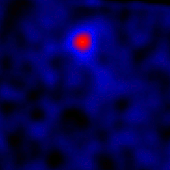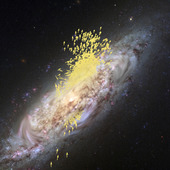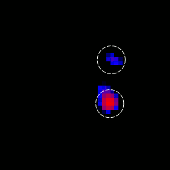ESA Science & Technology - News Archive
News archive
News archive
Astronomers using data from the NASA/ESA Hubble Space Telescope have employed a revolutionary method to detect dark matter in galaxy clusters. The method allows astronomers to "see" the distribution of dark matter more accurately than any other method used to date and it could possibly be used to explore the ultimate nature of dark matter.
Published: 20 December 2018
The Characterising Exoplanet Satellite, CHEOPS, will target 15 October to 14 November 2019 for launch.
Published: 23 November 2018
Based on a new theoretical model, a team of scientists explored the rich data archive of ESA's XMM-Newton and NASA's Chandra space observatories to find pulsating X-ray emission from three sources.
Published: 21 November 2018
In order to observe billions of faint galaxies and investigate the nature of the dark Universe, ESA's pioneering Euclid mission will require state-of-the-art optics. The first optical element to be delivered, the telescope's primary mirror (M1), has arrived at the premises of Airbus Defence & Space in Toulouse.
Published: 15 November 2018
ESA's Gaia mission has made a major breakthrough in unravelling the formation history of the Milky Way. Instead of forming alone, our Galaxy merged with another large galaxy early in its life, around 10 billion years ago.
Published: 31 October 2018
The NASA/ESA Hubble Space Telescope has captured part of the wondrous Serpens Nebula, lit up by the star HBC 672. This young star casts a striking shadow – nicknamed the Bat Shadow – on the nebula behind it, revealing telltale signs of its otherwise invisible protoplanetary disc.
Published: 31 October 2018
About 550 light-years away in the constellation of Cassiopeia lies IC 63, a stunning and slightly eerie nebula. Also known as the ghost of Cassiopeia, IC 63 is being shaped by radiation from a nearby unpredictably variable star, Gamma Cassiopeiae, which is slowly eroding away the ghostly cloud of dust and gas.
Published: 25 October 2018
The construction of ESA's PLATO mission to find and study planets beyond our Solar System will be led by Germany's OHB System AG as prime contractor, marking the start of the full industrial phase of the project.
Published: 4 October 2018
Scanning the sky for X-ray sources, ESA's XMM-Newton X-ray observatory has been busy with the XXL Survey, its largest observational programme to date. The second batch of data from the survey has just been released, including information on 365 galaxy clusters, which trace the large-scale structure of the Universe and its evolution through time,...
Published: 4 October 2018
Using the NASA/ESA Hubble Space Telescope and older data from the Kepler Space Telescope two astronomers have found the first compelling evidence for a moon outside our own Solar System. The data indicate an exomoon the size of Neptune, in a stellar system 8000 light-years from Earth. The new results are presented in the journal Science Advances.
Published: 3 October 2018
A team of astronomers using the latest set of data from ESA's Gaia mission to look for high-velocity stars being kicked out of the Milky Way were surprised to find stars instead sprinting inwards – perhaps from another galaxy.
Published: 2 October 2018
Using data from ESA's Gaia stellar surveyor, astronomers have identified four stars that are possible places of origin of 'Oumuamua, an interstellar object spotted during a brief visit to our Solar System in 2017.
Published: 25 September 2018
ESA's star mapping mission, Gaia, has shown our Milky Way galaxy is still enduring the effects of a near collision that set millions of stars moving like ripples on a pond.
Published: 19 September 2018
The NASA/ESA Hubble Space Telescope has started a new mission to shed light on the evolution of the earliest galaxies in the Universe. The BUFFALO survey will observe six massive galaxy clusters and their surroundings. The first observations show the galaxy cluster Abell 370 and a host of magnified, gravitationally lensed galaxies around it.
Published: 13 September 2018
Two plaques etched with thousands of miniaturised drawings made by children have been unveiled in a dedicated ceremony held today in Switzerland.
Published: 27 August 2018
Proposals are solicited for observations with XMM-Newton in response to the eighteenth Announcement of Opportunity, AO-18, issued 21 August 2018. This AO covers the period May 2019 to April 2020 and is open to proposers from all over the world. The deadline for proposal submission is 5 October 2018, 12:00 UTC.
Published: 21 August 2018
The mass of a very young exoplanet has been revealed for the first time using data from ESA's star mapping spacecraft Gaia and its predecessor, the quarter-century retired Hipparcos satellite.
Published: 20 August 2018
An enigmatic X-ray source revealed as part of a data-mining project for high-school students shows unexplored avenues hidden in the vast archive of ESA's XMM-Newton X-ray Observatory.
Published: 10 August 2018
The Planck consortium has made their final data release, including new processing of the cosmic microwave background temperature and polarisation data. This legacy dataset confirms the model of an 'almost perfect Universe', with some remaining oddities giving researchers some intriguing details to puzzle over.
Published: 17 July 2018
An international team has found first evidence of a source of high-energy neutrinos: a flaring active galaxy, or blazar. Following a detection by the IceCube Neutrino Observatory, ESA's INTEGRAL satellite joined a collaboration of observatories in space and on the ground that kept an eye on the neutrino source, heralding the thrilling future of...
Published: 12 July 2018
—
20 Items per Page




















